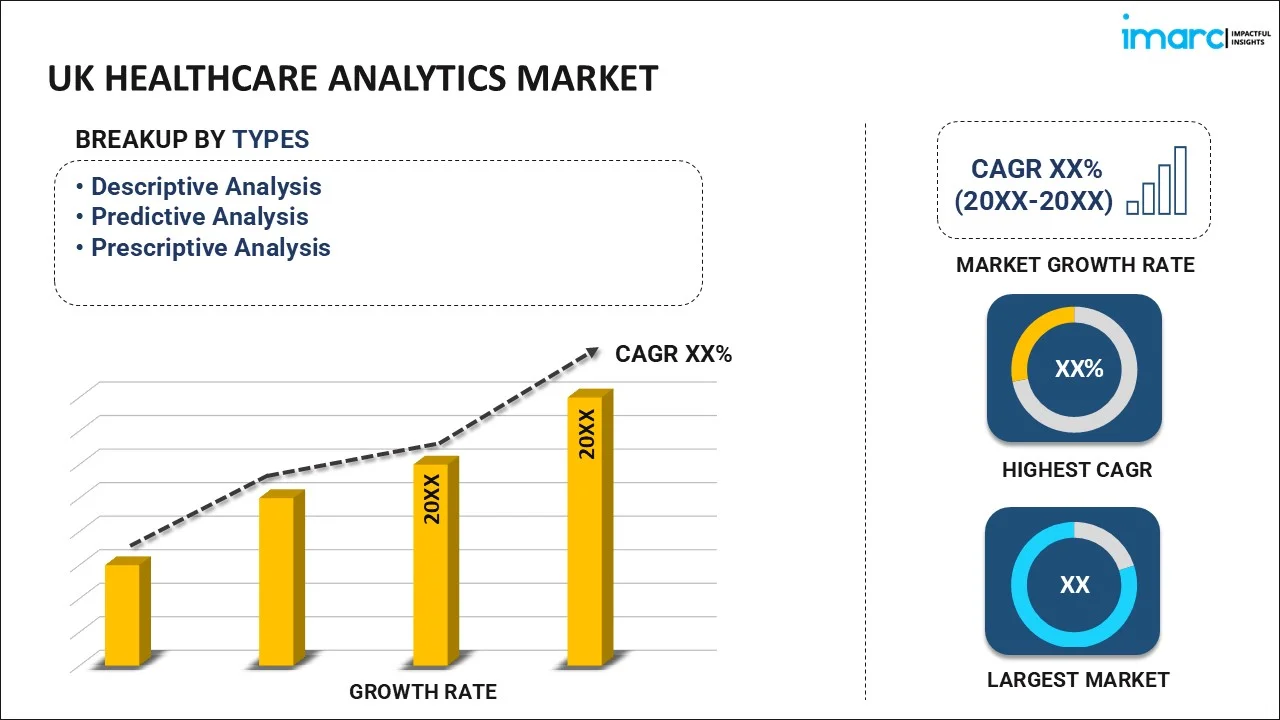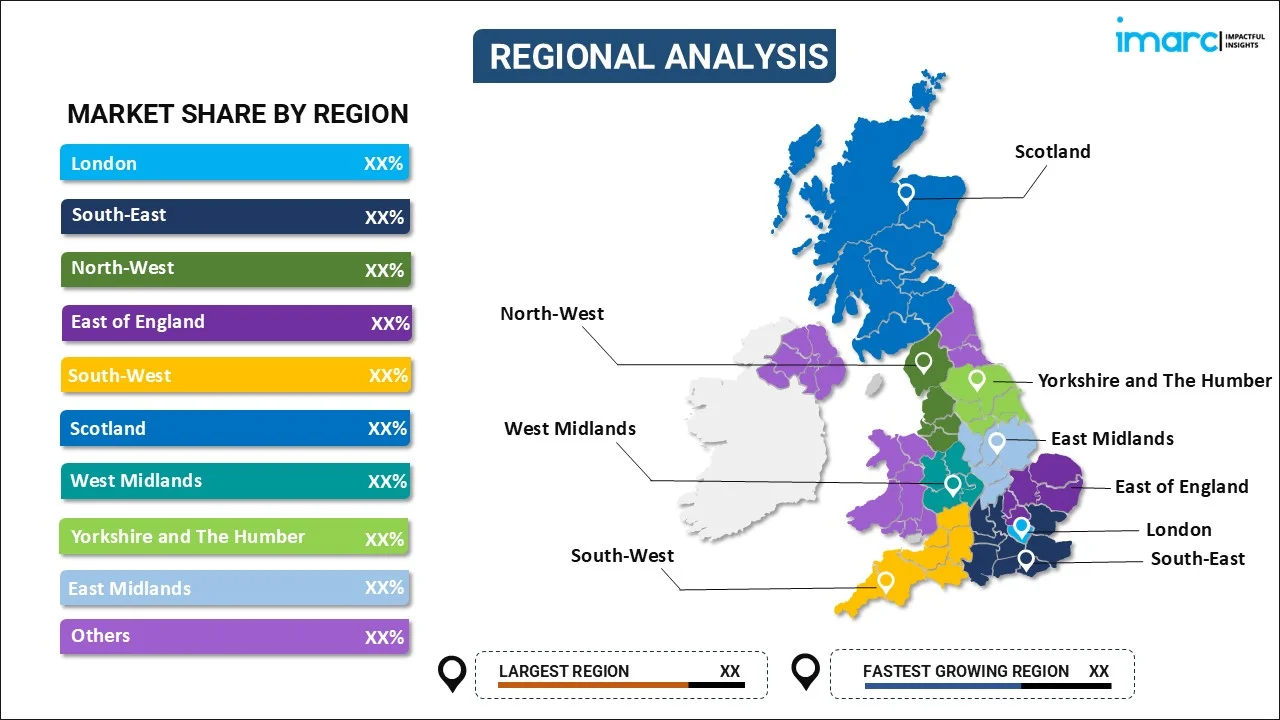
UK Healthcare Analytics Market Size, Share, Trends and Forecast by Type, Component, Delivery Mode, Application, End-Use, and Region, 2025-2033
UK Healthcare Analytics Market Overview:
The UK healthcare analytics market size reached USD 1.48 Billion in 2024. Looking forward, IMARC Group expects the market to reach USD 9.92 Billion by 2033, exhibiting a growth rate (CAGR) of 23.56% during 2025-2033. The widespread adoption of predictive analytics tools in the healthcare sector, increasing usage of artificial intelligence (AI) and machine learning (ML) to improve patient care, and rising use of population health management (PHM) solutions to enhance health outcomes of entire populations are some of the factors supporting the growth of the market.
|
Report Attribute
|
Key Statistics
|
|---|---|
|
Base Year
|
2024 |
|
Forecast Years
|
2025-2033
|
|
Historical Years
|
2019-2024
|
| Market Size in 2024 | USD 1.48 Billion |
| Market Forecast in 2033 | USD 9.92 Billion |
| Market Growth Rate (2025-2033) | 23.56% |
UK Healthcare Analytics Market Trends:
Increasing Adoption of Predictive Analytics Tools
Predictive analytics tools are becoming increasingly popular in the healthcare domain in the UK to enhancing patient conditions, optimizing resources, and minimizing costs of providing the healthcare services. In predictive analytics, the analysis of data from electronic health records (EHRs), medical devices, fitness bands, and other devices seeks to anticipate potential health complications prior to their occurrence. Furthermore, many companies, as well as regulatory bodies, are developing predictive analytic tools specifically for healthcare. For example, in 2023, the National Health Service (NHS) declared they would be creating the largest healthcare data platform to be used globally that will bring together all sources of health data so it can be used to better inform decision-making and patient outcomes.
Expanding Use of Population Health Management Solutions
In the UK health service, at present, population health management solutions have become increasingly important, since these can be great ways of improving health outcomes through analyzing data regarding various health-related factors. Such has always been the NHS advocacy for PHM, particularly in realizing its long-term goal of shifting to a more preventative model in healthcare. In the UK, several companies have also introduced PHM tools. These tools help identify at-risk populations, manage chronic conditions, and improve the outcomes of health care at lower costs. In 2024, collaborative research led by University of Oxford developed a new tool named QR4 that can accurately predict an individual’s 10-year risk of cardiovascular diseases like stroke.
Growth in Artificial Intelligence (AI) and Machine Learning (ML) Integration
According to an article published by The Health Foundation in 2024, more than three quarters of UK NHS staffs (76%) support the usage of artificial intelligence (AI) to improve patient care and 81% favor its use in administrative work. AI and machine learning (ML) are driving innovation in healthcare analytics, enabling more accurate diagnostics, treatment recommendations, and operational efficiencies. AI-driven healthcare analytics is reducing human error in diagnostics and improving patient outcomes by personalizing treatments based on data-driven insights. Effective analytics tools are becoming crucial in supporting healthcare professionals by providing real-time insights, enabling faster and more accurate decision-making, and reducing patient waiting times. The UK Government is recognizing AI’s potential to revolutionize healthcare. Moreover, in 2023, Accelerated Capability Environment (ACE) worked with the NHS AI lab to develop a pioneering AI tool to identify patients who are at risk of prolonged hospital stays. This tool focused on improving patient outcomes and also reduce healthcare costs.
UK Healthcare Analytics Market Segmentation:
IMARC Group provides an analysis of the key trends in each segment of the market, along with forecasts at the region level for 2025-2033. Our report has categorized the market based on type, component, delivery mode, application, and end-use.
Type Insights:

- Descriptive Analysis
- Predictive Analysis
- Prescriptive Analysis
The report has provided a detailed breakup and analysis of the market based on the type. This includes descriptive analysis, predictive analysis, and prescriptive analysis.
Component Insights:
- Software
- Hardware
- Services
A detailed breakup and analysis of the market based on the component have also been provided in the report. This includes software, hardware, and services.
Delivery Mode Insights:
- On-Premises
- Web-hosted
- Cloud-based
A detailed breakup and analysis of the market based on the delivery mode have also been provided in the report. This includes on-premises, web-hosted, and cloud-based.
Application Insights:
- Clinical
- Financial
- Operational and Administrative
A detailed breakup and analysis of the market based on the application have also been provided in the report. This includes clinical, financial, and operational and administrative.
End-Use Insights:
- Healthcare Payers
- Healthcare Providers
- Life Science Companies
A detailed breakup and analysis of the market based on the end-use have also been provided in the report. This includes healthcare payers, healthcare providers, and life science companies.
Regional Insights:

- London
- South East
- North West
- East of England
- South West
- Scotland
- West Midlands
- Yorkshire and The Humber
- East Midlands
- Others
The report has also provided a comprehensive analysis of all the major regional markets, which include London, South East, North West, East of England, South West, Scotland, West Midlands, Yorkshire and The Humber, East Midlands, and Others.
Competitive Landscape:
The market research report has also provided a comprehensive analysis of the competitive landscape. Competitive analysis such as market structure, key player positioning, top winning strategies, competitive dashboard, and company evaluation quadrant has been covered in the report. Also, detailed profiles of all major companies have been provided.
UK Healthcare Analytics Market News:
- March 2024: Researchers at King’s College London, UCL, King’s College Hospital NHS Foundation Trust, and Guy’s and St Thomas’ NHS Foundation Trust developed and tested a new AI tool called Foresight, which recognizes complex patterns in health data to gain insights and present prediction of future health of patients.
- May 2024: Vibrant Wellness announced its expansion into the UK market to offer precision lab testing and enhance patient care via innovative blend of biotechnology, academic research, and software solutions. Its entry in the UK brings a range of precision testing options like advanced toxin detection, gut health analysis, food reaction identification, and long term support via novel tests like oxidative stress profile.
UK Healthcare Analytics Market Report Coverage:
| Report Features | Details |
|---|---|
| Base Year of the Analysis | 2024 |
| Historical Period | 2019-2024 |
| Forecast Period | 2025-2033 |
| Units | Billion USD |
| Scope of the Report |
Exploration of Historical Trends and Market Outlook, Industry Catalysts and Challenges, Segment-Wise Historical and Future Market Assessment:
|
| Types Covered | Descriptive Analysis, Predictive Analysis, Prescriptive Analysis |
| Components Covered | Software, Hardware, Services |
| Delivery Modes Covered | On-Premises, Web-hosted, Cloud-based |
| Applications Covered | Clinical, Financial, Operational and Administrative |
| End-Uses Covered | Healthcare Payers, Healthcare Providers, Life Science Companies |
| Regions Covered | London, South East, North West, East of England, South West, Scotland, West Midlands, Yorkshire and The Humber, East Midlands, Others |
| Customization Scope | 10% Free Customization |
| Post-Sale Analyst Support | 10-12 Weeks |
| Delivery Format | PDF and Excel through Email (We can also provide the editable version of the report in PPT/Word format on special request) |
Key Questions Answered in This Report:
- How has the UK healthcare analytics market performed so far and how will it perform in the coming years?
- What is the breakup of the UK healthcare analytics market on the basis of type?
- What is the breakup of the UK healthcare analytics market on the basis of component?
- What is the breakup of the UK healthcare analytics market on the basis of delivery mode?
- What is the breakup of the UK healthcare analytics market on the basis of application?
- What is the breakup of the UK healthcare analytics market on the basis of end-use?
- What is the breakup of the UK healthcare analytics market on the basis of region?
- What are the various stages in the value chain of the UK healthcare analytics market?
- What are the key driving factors and challenges in the UK healthcare analytics?
- What is the structure of the UK healthcare analytics market and who are the key players?
- What is the degree of competition in the UK healthcare analytics market?
Key Benefits for Stakeholders:
- IMARC’s industry report offers a comprehensive quantitative analysis of various market segments, historical and current market trends, market forecasts, and dynamics of the UK healthcare analytics market from 2019-2033.
- The research report provides the latest information on the market drivers, challenges, and opportunities in the UK healthcare analytics market.
- Porter's five forces analysis assist stakeholders in assessing the impact of new entrants, competitive rivalry, supplier power, buyer power, and the threat of substitution. It helps stakeholders to analyze the level of competition within the UK healthcare analytics industry and its attractiveness.
- Competitive landscape allows stakeholders to understand their competitive environment and provides an insight into the current positions of key players in the market.
Need more help?
- Speak to our experienced analysts for insights on the current market scenarios.
- Include additional segments and countries to customize the report as per your requirement.
- Gain an unparalleled competitive advantage in your domain by understanding how to utilize the report and positively impacting your operations and revenue.
- For further assistance, please connect with our analysts.
 Request Customization
Request Customization
 Speak to an Analyst
Speak to an Analyst
 Request Brochure
Request Brochure
 Inquire Before Buying
Inquire Before Buying




.webp)




.webp)












